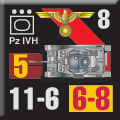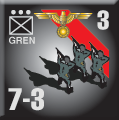| Dishonor Before Death:
Scenario Preview, Part Six
By Mike Bennighof, Ph.D.
December 2020
 There is never a bad time to fight evil, and Panzer Grenadier: Dishonor Before Death lets you fight evil 30 times, as the U.S. Army beats up on the Waffen SS party militia in the summer of 1944. We put surrendering SS men on the cover and included 165 SS pieces in black livery. But as Mike Perryman, the designer of those scenarios, reminded me this morning, it’s not their story. It’s the story of the American soldier who left his home and steamed across an ocean to defeat evil. There is never a bad time to fight evil, and Panzer Grenadier: Dishonor Before Death lets you fight evil 30 times, as the U.S. Army beats up on the Waffen SS party militia in the summer of 1944. We put surrendering SS men on the cover and included 165 SS pieces in black livery. But as Mike Perryman, the designer of those scenarios, reminded me this morning, it’s not their story. It’s the story of the American soldier who left his home and steamed across an ocean to defeat evil.
The Americans appearing in Dishonor Before Death are, as they so aptly named themselves, “General Issue.” They have no special political formations like the SS, because in 1944 the ideals of freedom and democracy were shared American values. They do have some special elite formations that appear in the scenarios, like the 82nd and 101st Airborne Divisions, but for the most part the battles are fought by line formations, many of them National Guard outfits. Guardsmen from Nebraska (the 134th infantry), Iowa (the 113th “Red Horse Cavalry”) and North Carolina (120th Infantry) are the heroes here.
So let’s have a look at one of the U.S. Army’s epic stands, as the 30th Infantry Division proves it still has tar on its heels when the Nazi hordes rush at them.
Chapter Six
Operation Lüttich: Hill 285
 On August 6, Col. Hammond Birks and his 120th Infantry Regiment of the North Carolina National Guard’s 30th Infantry Division - the 3rd North Carolina of Civil War fame - took over defense of Mortain and the two hills dominating the small town. A Regular Army officer who had been tapped as a company commander at age 22 during the Great War, Birks had been told that he occupied a “quiet sector.” The 18th Infantry Regiment of the 1st Infantry Division had taken Mortain a few days earlier and prepared no defenses, as the Germans were in no condition to counter-attack. VIII Corps headquarters, also sure of this, stripped away Birks’ 3rd Battalion and attached it to 2nd Armored Battalion. On August 6, Col. Hammond Birks and his 120th Infantry Regiment of the North Carolina National Guard’s 30th Infantry Division - the 3rd North Carolina of Civil War fame - took over defense of Mortain and the two hills dominating the small town. A Regular Army officer who had been tapped as a company commander at age 22 during the Great War, Birks had been told that he occupied a “quiet sector.” The 18th Infantry Regiment of the 1st Infantry Division had taken Mortain a few days earlier and prepared no defenses, as the Germans were in no condition to counter-attack. VIII Corps headquarters, also sure of this, stripped away Birks’ 3rd Battalion and attached it to 2nd Armored Battalion.
 Birks agreed with his staff that Mortain would make a fine vacation spot. And then he ordered them to dig in, and parceled out his attached company of 3-inch anti-tank guns from the 823rd Tank Destroyer Company between Mortain and Hills 314 and 285. Birks didn’t actually think that the Germans would attack. But if they did, his Tarheels would be ready for them. Birks agreed with his staff that Mortain would make a fine vacation spot. And then he ordered them to dig in, and parceled out his attached company of 3-inch anti-tank guns from the 823rd Tank Destroyer Company between Mortain and Hills 314 and 285. Birks didn’t actually think that the Germans would attack. But if they did, his Tarheels would be ready for them.
Scenario Nineteen
Hill 285
7 August 1944
 The 2nd SS Panzer Division launched its main effort at the town of Mortain, held by the 120th Infantry’s Company K, left behind when 3rd Battalion departed the area. To the north the SS division sent a battle group of the hapless 17th SS Panzer Grenadier Division. Under cover of fog, with no artillery preparation to alert the defenders, the Nazi militiamen reached the American main line of resistance. A roadblock manned by 1st Battalion’s Company B - untouched by that missing artillery preparation - held up the advance and a sharp firefight erupted. The 2nd SS Panzer Division launched its main effort at the town of Mortain, held by the 120th Infantry’s Company K, left behind when 3rd Battalion departed the area. To the north the SS division sent a battle group of the hapless 17th SS Panzer Grenadier Division. Under cover of fog, with no artillery preparation to alert the defenders, the Nazi militiamen reached the American main line of resistance. A roadblock manned by 1st Battalion’s Company B - untouched by that missing artillery preparation - held up the advance and a sharp firefight erupted.
Conclusion
 The SS militia fought their way past the roadblock, but Company A drove them off when they tried to climb the nearby Hill 285. The Germans redoubled their efforts, attacking both companies with the eight Panzer IV tanks provided by 2nd SS Panzer Division providing close fire support. That ended when Company B’s commander, Lt. Murray Pulver, picked up a bazooka and knocked out one of the tanks, causing the infantry to falter. The Germans rallied and made one more attempt just as the fog lifted, and that gave the gunners of 823rd Tank Destroyer Battalion the visibility they needed to destroy two more of them. That caused the SS militia to break and run, ending the fight for Hill 285 for the day. The SS militia fought their way past the roadblock, but Company A drove them off when they tried to climb the nearby Hill 285. The Germans redoubled their efforts, attacking both companies with the eight Panzer IV tanks provided by 2nd SS Panzer Division providing close fire support. That ended when Company B’s commander, Lt. Murray Pulver, picked up a bazooka and knocked out one of the tanks, causing the infantry to falter. The Germans rallied and made one more attempt just as the fog lifted, and that gave the gunners of 823rd Tank Destroyer Battalion the visibility they needed to destroy two more of them. That caused the SS militia to break and run, ending the fight for Hill 285 for the day.
Notes
The Germans out-number the American defenders two to one, they have tanks while the Americans do not, and they have more artillery support. The Americans have the high ground.
Scenario Twenty
National Socialist Ardor
8 August 1944
 A German night attack managed to gain a foothold on Hill 285, but Lt. Francis Connors of Company A rallied his men to counter-attack and drive the SS militia back off the slopes with heavy losses. German probes continued through the day, and when Connors told his men to conserve their dwindling ammunition, Hauptsturmführer Karl Ullrich decided that the Americans had pulled out and excitedly sent his party militia up the hill. Ullrich was mistaken. A German night attack managed to gain a foothold on Hill 285, but Lt. Francis Connors of Company A rallied his men to counter-attack and drive the SS militia back off the slopes with heavy losses. German probes continued through the day, and when Connors told his men to conserve their dwindling ammunition, Hauptsturmführer Karl Ullrich decided that the Americans had pulled out and excitedly sent his party militia up the hill. Ullrich was mistaken.
Conclusion
 Veterans of the fight later reported that despair took hold among the American defenders as the morning went on as no food or ammunition arrived and the wounded went without care. Yet when Ullrich’s SS militia charged up the slopes screaming “Heil Hitler!” the Tarheels became infuriated and poured lead into them. The attack broke, and its shattered survivors huddled in the foxholes left by Company B’s retreat. Veterans of the fight later reported that despair took hold among the American defenders as the morning went on as no food or ammunition arrived and the wounded went without care. Yet when Ullrich’s SS militia charged up the slopes screaming “Heil Hitler!” the Tarheels became infuriated and poured lead into them. The attack broke, and its shattered survivors huddled in the foxholes left by Company B’s retreat.
Notes
I’m not sure how many times I’ve used this scenario title, but it’s been a few and always for instances of mass SS battlefield cowardice. That definition leaves many choices. The militia have gotten pretty wretched by this point, and they have to come right at the Americans if they want to win. The Americans know this.
Scenario Twenty-One
Blood and Soil
11 August 1944
 Interrogations of German prisoners revealed that the SS militia clinging to the fringe of Hill 285 teetered on the edge of hysterical panic. Birks ordered the two companies defending the rise to take advantage and toss the Germans off it, starting with the positions originally held by Company B. Interrogations of German prisoners revealed that the SS militia clinging to the fringe of Hill 285 teetered on the edge of hysterical panic. Birks ordered the two companies defending the rise to take advantage and toss the Germans off it, starting with the positions originally held by Company B.
Conclusion
American patrols pushed the Germans out of the old Company B positions in the morning, easing the American task. The main attack went forward after an artillery barrage, and most of the SS militia tossed aside their weapons and fled in panic. Prisoners claimed that a hard core of battle-hungry fanatics planned to counter-attack, but no such hard core existed in the Götz von Berlichingen Division.
Notes
 This time the Americans get to attack, and the SS militia is in really poor shape. That means that the Americans have to achieve a lot in order to win, and they have the advantages of morale, leadership and artillery to make that happen. This time the Americans get to attack, and the SS militia is in really poor shape. That means that the Americans have to achieve a lot in order to win, and they have the advantages of morale, leadership and artillery to make that happen.
And that’s Chapter Six. Next time, it’ll be Chapter Seven.
You can order Dishonor Before Death right here.
Sign up for our newsletter right here. Your info will never be sold or transferred; we'll just use it to update you on new games and new offers.
Mike Bennighof is president of Avalanche Press and holds a doctorate in history from Emory University. A Fulbright Scholar and NASA Journalist in Space finalist, he has published countless books, games and articles on historical subjects.
He lives in Birmingham, Alabama with his wife, three children and his dog, Leopold. Leopold is a good dog.
|
